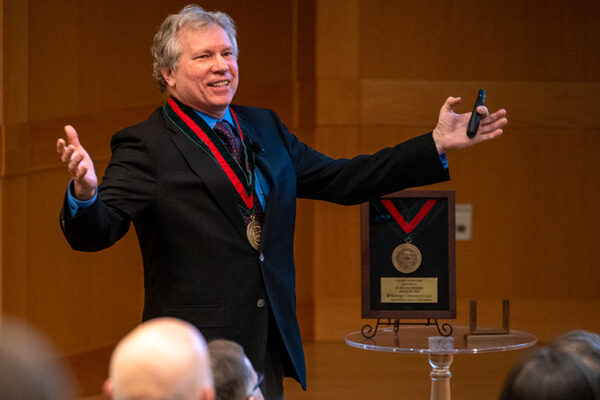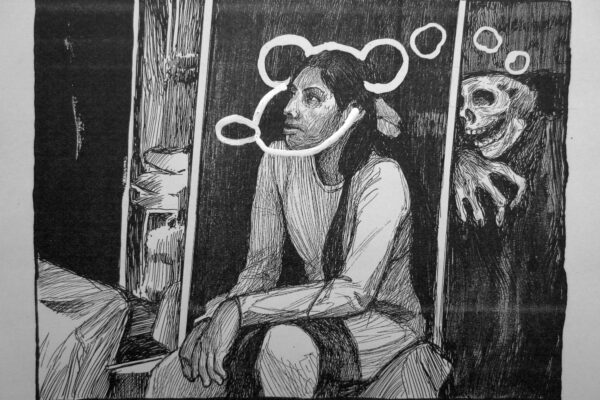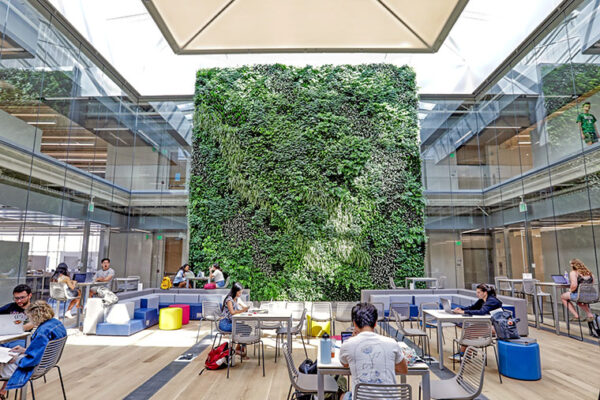
Claudia Swan has been named the inaugural Mark Steinberg Weil Professor of Art History and Archaeology at Washington University in St. Louis. A lecture and reception to celebrate her appointment were held Feb. 22 in the Kuehner Family Court in Anabeth and John Weil Hall.
A specialist in early modern northern European art, Swan joined the Department of Art History and Archaeology in Arts & Sciences in 2021. Her work on early modern art and visual culture explores the intersections of art history, the history of science, material culture studies and the history of global trade and politics.
Swan’s endowed position was made possible by a gift from Mark S. Weil, the E. Desmond Lee Professor Emeritus for Collaboration in the Arts. Weil spent more than four decades at Washington University as a student, faculty member, department chair and director of the Washington University Gallery of Art. He died in 2021.
“Washington University is honored to name Claudia Swan as the inaugural Mark Steinberg Weil Professor,” said Chancellor Andrew D. Martin. “Claudia is a wonderful, incisive scholar and a great addition to the department that Mark did so much to sustain. We are proud to celebrate them both with this endowed professorship.”
“Claudia’s work is especially important because it explores the ways images and their distribution helped to shape emerging European scientific practice,” said Feng Sheng Hu, dean of Arts & Sciences and the Lucille P. Markey Distinguished Professor. “I am thrilled that Washington University is able to recognize her scholarship in such a meaningful way.”
Elizabeth C. Childs, the Etta and Mark C. Steinberg Professor of Art History and chair of Art History and Archaeology, added that “Claudia’s scholarship is truly remarkable. The department has never before had a colleague with such expertise in early modern Netherlands. Claudia, who is bilingual in Dutch, has opened both our intellectual and our geographic horizons.”

About Claudia Swan
Drawing on multiple disciplines, Swan’s work aims to understand how images operated within the 17th-century Scientific Revolution; how theories of the imagination inform and shape visual and textual practices; and how foreign trade, diplomacy, and material and visual culture are enmeshed with the history of the Dutch Republic.
Swan is author of “Rarities of These Lands: Art, Trade, and Diplomacy in the Dutch Republic” (2021), published by Princeton University Press. The book explores how the trade in foreign goods, and diplomatic relations with the Ottoman Empire and other Muslim powers, shaped national self-conception.
She is also author of “Art, Science, and Witchcraft in Early Modern Holland: Jacques de Gheyn II: (1565-1629)” (2005) and co-author of “Conchophilia: Shells, Art, and Curiosity in Early Modern Europe” (2021).
Other publications include the co-edited volume “Image, Imagination, and Cognition: Medieval and Early Modern Theory and Practice” (2018); the edited volume “Tributes to David Freedberg: Image and Insight” (2019); and recent articles on 17th-century taste, Dutch art, trade and global diplomacy.
Swan earned a bachelor’s degree in art history from Columbia University in 1986 and a master’s in art history from Johns Hopkins University in 1987. She earned her doctorate in art history from Columbia University in 1997. Before coming to WashU, she spent more than two decades at Northwestern University, where she chaired the art history department from 2007-2010. She previously taught at The Pennsylvania State University.

About Mark S. Weil
Born in St. Louis in 1939, Weil earned a bachelor’s degree in art history and archaeology from Washington University in 1961. He joined the faculty in 1968, shortly after earning a doctorate in art history from Columbia University, and served two terms as department chair, from 1982-88 and from 1995-99. He was appointed a professor emeritus in 2005.
Weil’s scholarship fell into four primary areas: Italian Baroque sculpture, 16th- and 17th-century garden and stage design, the idea of the Marvelous, and art connoisseurship. He was the author of “The History and Decoration of the Ponte S. Angelo” and numerous articles and exhibition catalogs. His final manuscript, “Giorgio Ghisi, The Allegory of Human Life: An Analysis Centered on Isabella D’Este and Her Heritage,” was completed just months before his death.
In 1998, Weil was named director of the Gallery of Art, now the Mildred Lane Kemper Art Museum, for which he organized several major exhibitions. He also helped create the master plan that would link the museum and the university’s art and architecture schools in what then became the Sam Fox School of Design & Visual Arts.
Weil’s philanthropy has supported a range of institutions and arts programs, including Dieu Donné, the Rhode Island School of Design and the Saint Louis Art Museum. In 2019, Weil and his wife, artist Joan M. Hall, the Kenneth E. Hudson Professor Emerita in the Sam Fox School, established the Mark S. Weil and Joan M. Hall Fund for Art History and Archaeology in Arts & Sciences, which supports several annual research awards, fellowships and internships for both faculty and students. Two years later, they expanded those efforts with a substantial gift to found the Mark S. Weil and Joan M. Hall Endowment for Art History and Archaeology.
The commitment to Washington University runs deep in Weil’s family. Steinberg Hall, which today houses classrooms and studios for art and architecture students, and Steinberg Auditorium, which serves the needs of the broader campus, were both a gift from his grandmother, Etta E. Steinberg, in memory of his grandfather, Mark C. Steinberg. She also created the Etta and Mark C. Steinberg Professorship in Art History.
Weil’s parents, Florence and Richard Weil, contributed many works of art to the university collection, and Richard served on the university Board of Trustees. To honor their mother’s memory, Mark and his siblings — Richard, John and the late Paula Weil — and their spouses supported the creation of the Kemper Art Museum’s Florence Steinberg Weil Sculpture Garden. John, an emeritus trustee, and his wife, Anabeth, recently supported creation of the Anabeth and John Weil Hall.









